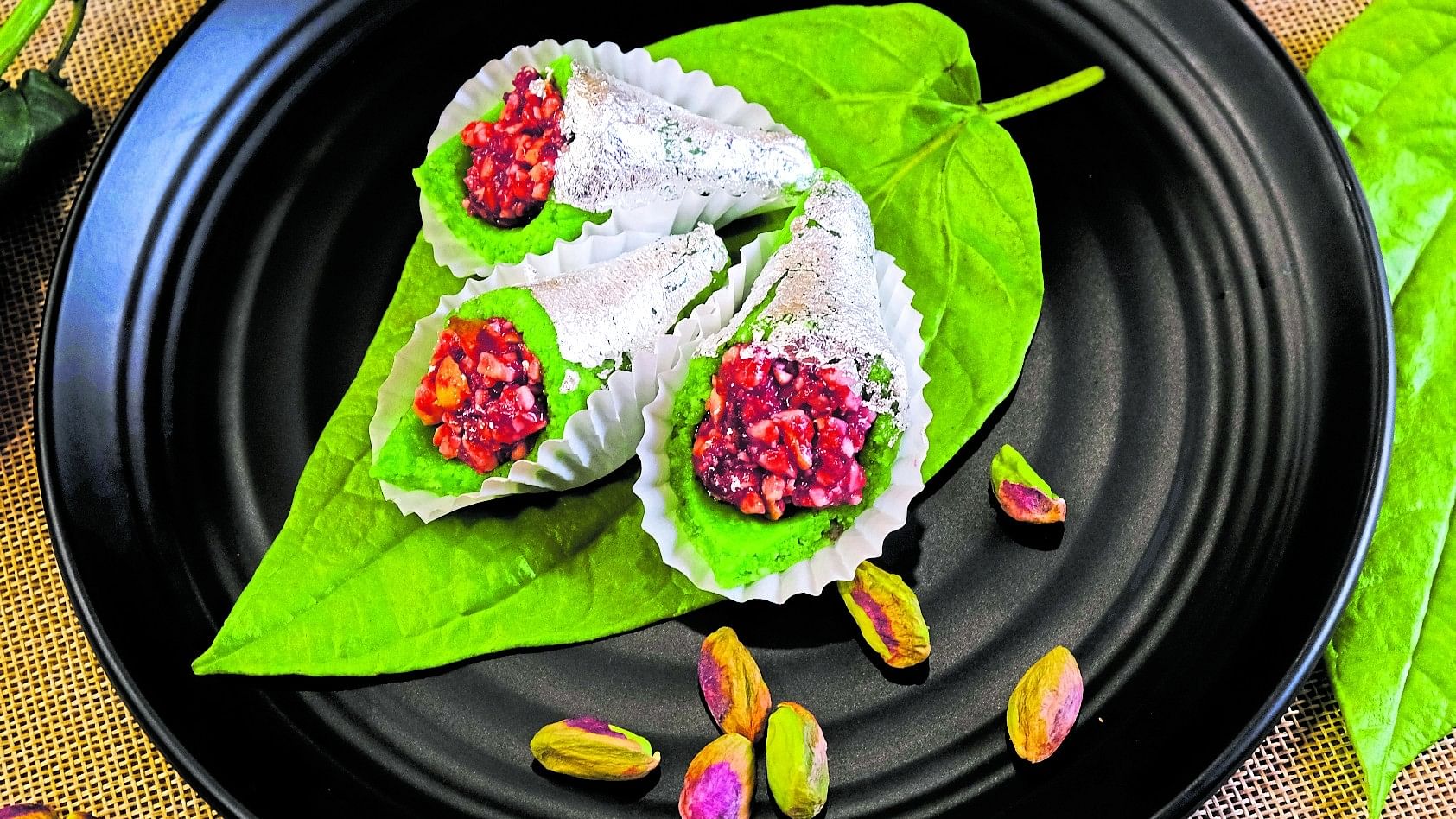
Paan mithai.
Credit: iStock Photo
India has a rich history of great cuisine that combines a wide range of tastes, aromas, and textures. Paan was formerly used as a digestive aid and mouth freshener, but it has evolved significantly through time — from a simple dish to a colourful dessert with a wide range of flavours. Let’s embark on a journey to see how paan, a classic Indian delicacy, has been modernised.
The origins
Paan, which is derived from the Sanskrit word parna which means leaf, has played a significant role in Indian culture for many years. It was first produced in ancient India where people ate it for both its therapeutic benefits and its symbolic value.
Betel leaf, areca nut, slaked lime, and different aromatic components including cardamom, cloves, and saffron made up the original paan.
This uncomplicated but effective concoction of components was known to improve digestion, freshen breath, and act as a mild stimulant.
A modern twist
The famous song Khaike Paan Banaras Wala popularised the classic paan and made Banaras (Varanasi) synonymous with this tasty dessert. Paan used to be mostly offered in its traditional form, with a few variants. After meals, everyone enjoyed the traditional paan appreciating the explosion of flavours and the lasting spicy-sweet notes it left one with.
The dessert sector, however, underwent a substantial transition with the passage of time and the onset of globalisation, giving rise to a modernised version of paan. Entrepreneurs who spotted the potential in this traditional treat were responsible for modernising paan as an Indian dessert.
To accommodate evolving consumer tastes and preferences, they began experimenting with unexpected flavour combinations and creating a wide range of paan variations. Paan booths and speciality stores began selling a variety of flavours that included ice cream, chocolate, fruit syrups, and even alcohol.
Paan, originally a customary dessert, has evolved into a delicacy with hundreds of flavour possibilities. If you like the luxury of chocolate, butterscotch, or caramel, or the fruity delights of mango, strawberry, or pineapple in ice creams, you can also experiment with paan flavour now.
Exotic concoctions such as paan kulfi, paan gulkand, and paan panna cotta are available for those looking for a one-of-a-kind experience, infusing the flavour of paan with other desserts to create beautiful fusions.
Paan as a social symbol
Along with shifting flavours, paan has come to symbolise joy and welcome in Indian culture. Paan is an important part of Indian traditions and customs. It is offered to visitors as a mark of deference and welcome, evoking hospitality and generosity. Paan, which stands for blessings and fortune, is commonly used in religious rituals and weddings. Additionally, chewing paan has developed into a social custom that brings people together for discussions and storytelling.
Paan earns special praise across the world for its unparalleled taste and flavour. Talking about its cultural significance, Prem Raheja, CEO, The Betel Leaf Company, states, “Paan is not just a traditional Indian dessert, it is a cultural icon that has been passed down for generations. It is important to preserve this heritage while also evolving and expanding its potential in India and globally.”
While in conversation about this delectable dessert, Kabita Singh, founder of Kabita’s Kitchen Masala Mix recalls, “I would like to share a story. As a kid, I loved paan (meetha paan) but my parents didn’t allow us to have it. However, I found a way around it. My dad used to buy paan from a particular shop. Sometimes, I used to go to that shop and say ‘uncle,
papa ke liye ek meetha paan bana dijiye’, and he would give the paan. On my way back from the shop I used to consume it. I chose a
time when my mom would be asleep so that I could rinse my mouth before she woke up.”
The global appeal of paan
Paan, once a simple leaf-based digestive, has embraced modernity and become a lively Indian dessert. The transformation of this dessert from the renowned Khaike Paan Banaras Wala to one with hundreds of flavours exemplifies the versatility of Indian cuisine and the innovation of its people.
Paan’s evolution as a dessert reflects changing customer tastes and preferences, as well as the entrepreneurial spirit of entrepreneurs who have transformed a traditional delicacy into a delectable delight.
In order to satisfy a variety of palates, the modernised paan offers a wide range of flavours, from traditional to exotic.
It now adorns important occasions with its elegance and charm, serving as a symbol of celebration and hospitality. Pushing the limits of flavour pairings and presentation, paan stalls and specialist stores have developed into a hotbed of experimentation. Paan mousse, tres leches cake, paan waffle, gulkand dessert, paan truffles or even a paan cake are some quirky dishes to experiment with.
The modernisation of paan is evidence of Indian cuisine’s adaptability and ingenuity in a world where culinary traditions are continuously changing. So, the next time you enjoy an interesting paan dessert, take some time to appreciate its fascinating history and also the flavourful fusion that captures the essence of India’s culinary tradition.